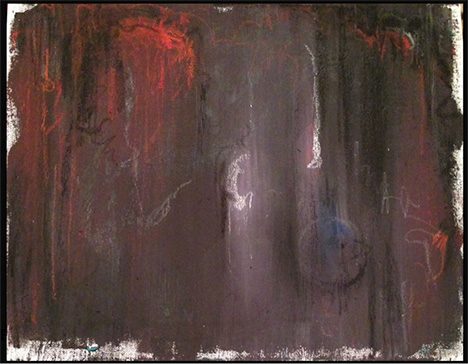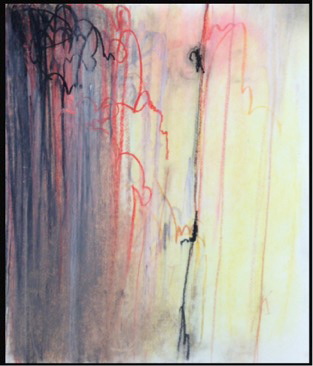I have always been a visual person. When I read a book, I see the characters’ faces. When I listen to music, I know how it moves. When I say the word “armchair,” I picture an armchair (purple, wooden legs).
When I was a kid, I thought everyone knew that A’s were yellow and 3’s were green. That “fairness” was blue and the phrase “wait and see” looked like a handful of white Styrofoam balls. My favorite color was the letter J, and I loved “P-U-F-F-I-N-S” because it felt so luxuriously soft.
Turns out, I have a touch of synesthesia (and a very vivid imagination). And while this doesn’t affect my daily life very much, it did help lead me to the field of art therapy.
Art therapy is a branch of counseling that encourages individuals to explore their thoughts and ideas visually. Art therapists believe the choices we make during the art process (how a material is manipulated, for example, or the words we use to describe our art) helps others understand how we perceive and move through the world.
In graduate school, my professors would ask us questions like:
Where in your body do you feel sadness?
What sound is that feeling?
What does that sound look like?
How big is that word?
These seemed like super, uh, far out questions at the time, and it took a while for my cohort and I to get used to using this type of language to describe our ideas, relationships, and emotions. I eventually drank the Kool-Aid, however, and didn’t feel as silly using my new far out language with my peers. The more I practiced reframing the way I saw and talked about my experiences, the better I understood why phrases like these have purpose (and substance). It’s now the way I relate to my clients in session.

Healing Piece. Acrylic paint on canvas. I completed this image in graduate school in response to the question, “What does it mean to heal?”
If I were asked to draw the “shape” of confidence, the first thing that comes to mind is a huge marshmallow. If I had to “color” of my fella’s name, I might use mint green, like toothpaste. To me, marshmallows are indulgent, soft, and child-like; and mint green toothpaste is domestic, intimate, and clean.
When I explore how the words “indulgent, soft, and child-like” relate to feeling confident, I learn a little something about how I understand confidence.
Soft, child-like… Tell me about the last time you felt confident.
Further, the descriptors “domestic, intimate, and clean” may help an outsider better understand the way I see my partner (or relationships in general).
Domestic and intimate sound positive to me… But tell me how you view them.
Art therapists walk alongside their clients during the art process to encourage ideas and discuss conclusions. As an aside, I’m not saying these conversations are unique to art therapy- on the contrary, art therapists and counselors come to similar conclusions because they work from a similar framework and toward similar goals. But the path differs.
Therapists (art therapists, in particular) get a bum rap as interpreters, mind-readers, and quacks… but that’s really not what’s going on here. Houses, trees, and people mean little without input from the artist- and art therapists are not in the business of putting words in your mouth (or pictures on your paper). Art therapists partner with their clients to discover symbols, themes, patterns, etc. in an art piece, explore their significance (or insignificance) and apply this knowledge to therapeutic goals.
Marshmallows are child-like and indulgent to this artist, but may be expensive, nauseating, or Ghost Buster-y to another.
In addition to being an art therapist, I also identify as an anxious person. At age 12, I began to socialize less, scrutinize myself more, and worry excessively about absolutely everything. As an adult, my anxious thoughts tell me I’m an incapable and unlikeable person who doesn’t have anything of value to share with the world. Art-making has made these thoughts feel less threatening and helped me talk about my experiences on my own terms. Seeing my anxiety objectively on paper, instead of feeling it in my body, also helps me find solutions to it.
Pictures can be a great jumping-off point for those of us who have trouble verbalizing emotions (due to trauma, a disability, anxiety, a preference for visual language, etc.). Art images encourage honesty, organization, and make our feelings heard. Art can be used to distract a stressed mind (see my post on the adult coloring book phenomenon here), foster confidence, and encourage us to sit in quiet and stillness (this is so important).
You don’t need to have synesthesia to benefit from art therapy, most people don’t. Art doesn’t always flow easily from our fingertips, art therapists get that and they’re here to help you get started. The goal of art therapy isn’t to hang your final art piece in a museum (though you may want to), it’s to develop a new language to describe experiences, feelings, events, and ideas. My clients have written their gratitude in love letters addressed to themselves, ripped up their memories and created new narratives from the scraps, and placed their hurt in carefully constructed boxes. Art therapy works, of that I am sure. But I would be honored to learn how it works for you.
Jess Kimmel, MSAT, LLPC is a limited licensed art therapist and counselor in the mid-Michigan area. She is currently employed as a Neuro Rehabilitation Aide at Hope Network East Lansing and a part-time Art Therapist at Sanford House in Grand Rapids. She can be contacted via her website www.jesskimmel.carbonmade.com. She enjoys writing, eating pizza, and watching too much true crime television.

